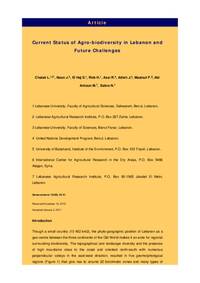Current Status of Agro-biodiversity in Lebanon and Future Challenges

Authors:
Though a small country, Lebanon hosts various ecosystems that allow for a large number of
plants ranging from cold requiring crops to subtropical ones to live and flourish. More than 80
plant species for food and agriculture are currently cultivated and/or utilized in the country,
excluding ornamental, medicinal, forest and forage plants. The main crops grown in Lebanon are
olives, fruit trees and cereals followed by tubers and fruity vegetables. Furthermore, a number of
species of the wild flora are harvested and used as food including aromatic plants, spices and
condiments. This paper reviews the currents status of plant genetic resources for food and
agriculture in the country with the multiple concerns and challenges regarding their sustainable
use, in-situ management and ex situ conservation over the recent years.
